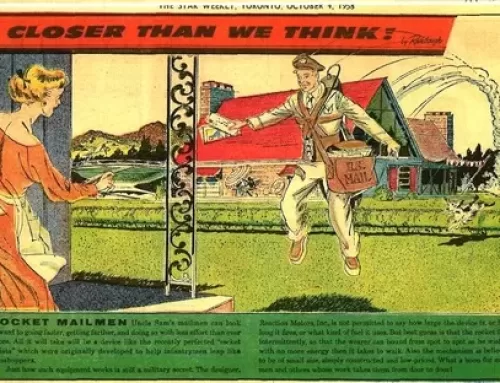On my bookshelf, surrounded by scores of futures books, is a 1949 volume published  by Simon and Schuster and authored by Egon Glesinger. The book is titled The Coming Age of Wood. Glesinger was Chief of the Forest Products Branch of the Food and Agriculture Organization of the United Nations, and was decades ahead of his time. Most people think of wood as an archaic and low-tech material. But in 1949, Mr. Glesinger foresaw the “revolutionary role it would play in our future.”
by Simon and Schuster and authored by Egon Glesinger. The book is titled The Coming Age of Wood. Glesinger was Chief of the Forest Products Branch of the Food and Agriculture Organization of the United Nations, and was decades ahead of his time. Most people think of wood as an archaic and low-tech material. But in 1949, Mr. Glesinger foresaw the “revolutionary role it would play in our future.”
Indicators of the coming age of wood can be found in the Forest Futures horizon scanning database, which includes links to many articles about significant innovations in wood products that could be game changers for forestry and forest products. Examples include:
- Wood-based nanomaterials have been produced at a pilot plant at the USFS Forest Products Lab in Madison, WI for more than 5 years. Other pilot plants are in operation around the world. There are thousands of uses for this renewable and biodegradable material in everything from computer chips, flexible computer displays, car panels, replacement tendons, and coatings to keep food fresh longer.
- Tall wood buildings or “plyscrapers” are sprouting up across the globe today, built with cross-laminated timber (CLT) and other “mass timber” technologies. CLT is made from layers of wood crisscrossed and held together by fire-resistant glue. It is as strong as structural steel, greatly speeds up construction, and has a much lower carbon footprint than steel and concrete buildings. Mass timber may be in the process of disrupting the construction and wood products industries.
- 3D printing using cellulose from wood pulp is just beginning, but it could be cheaper, stronger and more environmentally friendly than petroleum-based polymers currently widely used. A large amount of plastics could be replaced with this renewable material.
- Fabric made from wood fibers could revolutionize both the textile and forest industry. A company in Finland has developed a process that transforms wood fibers directly into yarn. It uses 99% less water and 80% less energy than producing cotton.
- Wood nails offer many advantages over fasteners made of aluminum or steel. LignoLoc® nails are compressed with a resin to make them hard. Their mechanical properties allow the nails to be driven into solid structural timber without drilling pilot holes, using a pneumatic nail gun.
- Transparent wood substitute for glass – A new process developed by Swedish scientists chemically removes lignin from natural wood fibers to produce clear windows and solar cells. This could be a cheaper substitute for traditional silica-based glass. The new process is thought to be particularly well-suited to large-scale applications and mass production.
- Biodegradable electronics could be developed using graphene made from wood in a new process created by scientists at Rice University. Graphene is usually a sheet of carbon just one atom thick – not practical to work with in that structure. The Rice researchers developed a way to make a 3-dimensional graphene foam by heating a piece of pine with an industrial laser under very specific conditions. They believe that someday “wooden electronics” could help curb the problem of e-waste.
These and other innovations suggest that a revolution in wood products is getting underway. A recent report from Dovetail Partners characterized this as “The Once and Future Bioeconomy.” Several wood products experts and the United Nations Economic Commission for Europe have declared that the 21st century could be the “century of wood.”
Implications of the coming age of wood could include:
- Increased demand for wood, increased tree planting to meet the demand, and resulting increased absorption of atmospheric carbon dioxide;
- Development of markets for wood currently lacking market value, thinning of overgrown forests with high fuel loads to supply the markets, resulting in decreased wildfire risk.
Architect Anthony Thistleton has observed that “The 20th Century was the concrete age, it was all about the dominion of [humans] over nature.” If Egon Glesinger is right, the concrete age could be yielding to the “Coming Age of Wood” in which an ancient and renewable material takes center stage. — Dave Bengston



